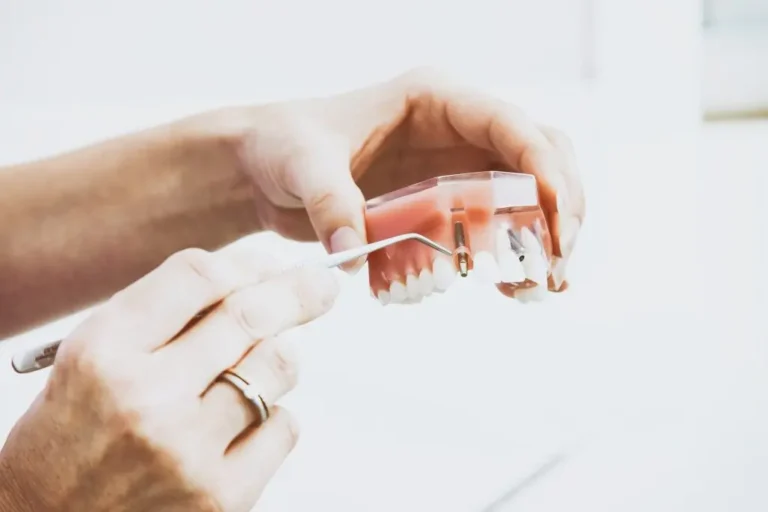Dental implants are a popular and effective solution for people who have lost one or more teeth due to injury, decay, or other reasons. The procedure involves placing a metal post into the jawbone, which serves as a replacement for the root of the missing tooth. A crown or other dental prosthesis is then attached to the post to complete the restoration. It is one of the many common services that you can get at any dental clinic. Follow this article to find out what other types of dental services are available at a clinic.
What Are Dental Implants ?
Dental implants are nothing but artificial tooth roots. These implants provide a permanent base for fixed or removable replacement teeth. They are made of biocompatible materials, such as titanium, that are surgically placed into the jawbone to mimic the root structure of a natural tooth.
Over time, the bone and tissue surrounding the implant integrate with the implant, forming a strong and stable foundation for the replacement tooth. The replacement tooth, typically a crown or bridge, is then attached to the implant and can restore the appearance, function, and feel of natural teeth.
Steps of the Dental Implant Process
The tooth implant procedure involves a few steps, and we’ve divided it into 7. The process is carried out at a dental clinic by a dental professional. It is a very common solution that is often recommended to many. Here is the step-by-step dental implant procedure:

Step 1: Consultation and Evaluation
To begin the dental implant process, you need to arrange a consultation with your dentist or oral surgeon. The consultation involves an examination of your mouth and taking X-rays to assess whether dental implants would be a suitable choice for you. They will also evaluate the health of your gums and jawbone, and discuss your medical history to make sure that you are a good candidate for the procedure.
Step 2: Planning and Preparation
Once your dentist or oral surgeon has determined that you are a good candidate for dental implants, they will create a treatment plan to meet your specific needs. This may involve creating a custom-made dental prosthesis, such as a crown or bridge, to ensure a perfect fit. Your dentist or oral surgeon may also use computer-aided design (CAD) and computer-aided manufacturing (CAM) technology to plan the placement of the implant and ensure that it is in the optimal position for success.
Step 3: Placement of the Implant
The placement of the dental implant involves a surgical procedure. During the procedure, the dentist or oral surgeon will make a small incision in the gum tissue and drill a hole into the jawbone to place the implant. The implant is then secured in place with a special screw or other fixation device. This part of the procedure is usually performed under local anesthesia or light sedation, so you will be awake but relaxed and comfortable.
Step 4: Healing and Osseointegration
After the dental implant is placed, the gum tissue will be closed over the implant with sutures. You will be given instructions on how to care for the surgical site, and you will need to avoid chewing on the implant site for a few weeks while the area heals. Over the next several months, the implant will fuse with the surrounding bone through a process called osseointegration. This is a critical step in the success of the implant, as it helps to ensure that the implant is strong and stable.
Step 5: Attachment of the Abutment
Once the implant has fully integrated with the jawbone, you will return to your dentist or oral surgeon for a follow-up appointment. During this appointment, the dentist will attach an abutment to the implant. The abutment serves as the connection between the implant and the dental prosthesis, and is used to secure the crown or other prosthesis in place.
Step 6: Placement of the Dental Prosthesis
After the abutment is attached, the dentist or oral surgeon will take impressions of your mouth to create the final dental prosthesis. This may be a crown, bridge, or other type of dental prosthesis, depending on your individual needs and the treatment plan that was created for you. Once the prosthesis is complete, it will be fitted over the abutment and secured in place.
Step 7: Maintenance and Follow-Up
After the dental implant procedure is complete, it is important to keep your gums and teeth healthy with good oral hygiene and regular dental check-ups. This will help to ensure the longevity and success of your dental implant, and help you to enjoy a healthy and beautiful smile for years to come.
Conclusion
To sum up, individuals who have lost one or more teeth often turn to dental implants as a widely accepted and successful option. Each step is critical to the success of the dental implant and must be performed by a skilled and experienced dental professional. With proper care and maintenance, dental implants can provide a natural-looking and functional solution for missing teeth, and can last for many years.
Since dental implants play such a vital role, it is important for any individual to get dental implants done by the right dentists. It is crucial for you to find the best dentists in your area and get this procedure done only by experts who know how to handle it with proper care. It is something that will stay with you for years to come, so a little precaution would be beneficial.
If you are considering dental implants, be sure to discuss your options with your dentist or oral surgeon to determine if they are right for you and how to proceed with them. You can visit City Dental Group today for the best Dentists in New York. Visit and get your consultation today. Know the entire process in detail and get step-by-step guidance for your dental implants today.





